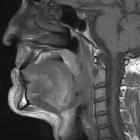Tonsillitis









Tonsillitis refers to inflammation of any of the tonsils and is one of the most common head and neck infections in adolescents and young adults.
Clinical presentation
Patients may present with a variety of symptoms including painful throat (may be unilateral), dysphagia, fevers, tender cervical lymphadenopathy and/or tonsillar exudate. Ear pain and trismus can also occur .
Pathology
Most commonly bacterial (group A beta-hemolytic Streptococci) but may also be due to viral infections (herpes virus, cytomegalovirus, adenovirus) .
Radiographic features
Imaging is not indicated in simple cases of tonsillitis but can be useful if there is doubt about the diagnosis, inability to examine the patient or concerns about the development of a peritonsillar abscess or other complications .
CT
- tonsillar enlargement, which may touch in the midline forming "kissing tonsils" and on non-contrast images may be iso- or hypodense
- contrast enhancing linear densities in the tonsils without focal fluid collection
- fat stranding in the parapharyngeal space
MRI
Typical signal characteristics are :
- T1: hypo- to isointense to surrounding muscles
- T2: hyperintense to surrounding muscles
Treatment
Tonsillitis is often treated with oral antibiotics. In severe cases inpatient admission for intravenous antibiotics and rehydration is sometimes required .
Complications
- If left untreated tonsillitis may spread to involve the peritonsillar space (a potential space between the tonsil capsule and the superior pharyngeal constrictor muscle) and form a peritonsillar abscess (quinsy).
- intratonsillar abscess
- Infection can spread to the adjacent retropharyngeal, parapharyngeal, masticator or submandibular spaces.
- otitis media
- obstructive sleep apnea (secondary to chronic tonsillitis)
Differential diagnosis
The differential diagnosis for a pharyngeal mucosal space mass also includes :
Siehe auch:
- Tonsillolith
- Tonsillenkarzinom
- Lymphom der Tonsille
- tonsillitis - kissing tonsils
- acute bacterial tonsillitis
und weiter:

 Assoziationen und Differentialdiagnosen zu Tonsillitis:
Assoziationen und Differentialdiagnosen zu Tonsillitis:
